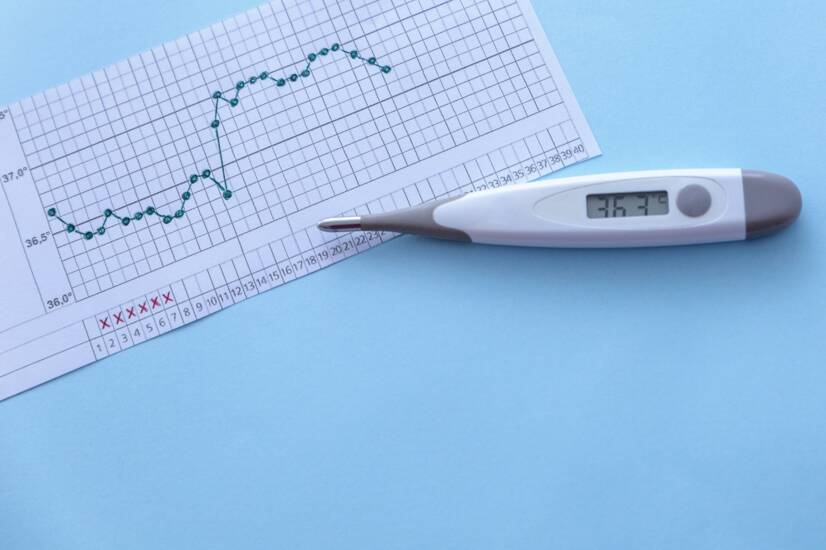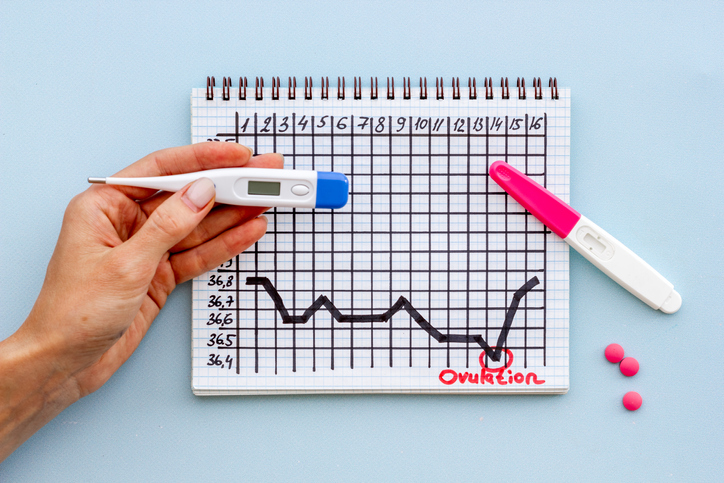- ČEPICKÝ, Pavel, ed. Kapitoly z diferenciální diagnostiky v gynekologii a porodnictví. Praha: Grada Publishing, 2018. ISBN 978-80-247-5604-2
- healthline.com - Ways to Track Your Basal Body Temperature for Fertility. Jessica Timmons
- naturalcycles.com - Basal Body Temperature Explained.
- ncbi.nlm.nih.gov - Physiology, Ovulation And Basal Body Temperature. Kaitlyn Steward, Avais Raja
Basal temperature: what is it used for and how to measure it correctly? When does it fall and when does it rise?

Measuring basal body temperature is one of the most commonly used methods for determining a woman's ovulation and fertile days. Basal temperature fluctuates with respect to the current phase of the menstrual cycle. What values to monitor, what to avoid and how to measure basal temperature correctly?
Article content
Basal body temperature
Basal Body Temperature (BT) is the basal temperature of the human body at rest or in resting mode. It is a symptothermal method based on the examination of a bodily symptom - the height of the temperature.
Basal temperature measurement is one of the basic indicators of a particular phase of a woman's cycle and fertile window. Apart from ovulation itself, a basal temperature chart can also reveal the approaching menstruation and any irregularities in a woman's menstrual cycle.
Basal temperature readings change depending on changes in the production and levels of the hormones estrogen and gestagen in the ovaries.
A certain basal body temperature is characteristic of every person.
Basal body temperature is measured in the mouth, vagina or anus. Women (especially those trying to conceive a child) regularly record their temperature readings in a chart or table.
Due to the risk of inaccurate measurements, inflammatory changes and processes in the body, this symptothermal method is definitely not a full protection against conceiving a child.
Principles of basal body temperature measurement
The basic rule for the highest success rate of temperature measurement is regularity and, if possible, equal body and time conditions of measurement.
Tips for accurate temperature measurement:
- Measure temperature at the same time with a maximum time deviation of half an hour
- Measuring the temperature in the same place with approximately the same ambient temperature
- Always use the same thermometer for measurements
- Use the same measurement location (mouth/face)
- Honestly observe the duration of the temperature measurement
- Measure temperature upon waking after at least 5 hours in bed
- Avoid physical activity before measurement
- Start of the first chart entry ideally on the first day of menstruation
- It is recommended to write down the reading immediately after the measurement
- Measurement deviations should always be written below the chart in the notes
Any physical and mental strenuous activity should be avoided before taking the temperature. Even performing a small need can change the measured value by a little.
The measured values may vary slightly from cycle to cycle due to possible changes, processes, inflammation and possible diseases in the body.
Factors affecting measurement inaccuracy:
- Inflammation and disease in the body
- Use of drug therapy
- Poor quality/poor sleep
- Alcohol consumption
- Physical and mental activity
- Emotional stress
- Other thermometer
- Large time variation in measurement
- Different room/environment
- Travel
- Different environmental climate
- Treatment/period of menopause
Choosing a suitable thermometer
It is important to use a good quality thermometer for effective and accurate measurements. A digital thermometer that reads to two decimal places is best.
Thermometers designed to measure basal temperature directly and shaped for measurement in the vagina are now freely available.
A mercury thermometer takes the temperature for about 5 minutes, a digital thermometer for about 2 minutes and usually beeps when measuring.
The basal temperature must be measured in the same place each time with the same thermometer - either in the oral cavity, in the vagina or in the rectum.
It should be noted that readings taken in the vagina tend to be about 0.3-0.6 degrees higher, so it is advisable to monitor the measurement site.
However, from the point of view of cleanliness, it may not be entirely practical for a woman to take measurements in the vagina/rectum. Washing the thermometer after each measurement is a hygiene precaution and a risk of infection.
Oral temperature measurements (in the mouth under the tongue) are most commonly used. However, rectal and vaginal temperature measurements tend to be slightly less accurate, as the oral measurement may be biased by changes in the oral environment.
The temperature measured in the mouth is usually about 0,5 °C lower than the temperature measured in the vagina or rectum.
Basal temperature during the menstrual cycle
During the menstrual cycle and in the period before ovulation (follicular phase of the cycle), a woman's basal temperature is lower. The day after ovulation, it rises and is higher until the last day before menstruation, when it starts to fall again.
The higher temperature is due to the rise in the hormone progesterone, which the corpus luteum begins to produce after ovulation (the luteal phase of the cycle).
During the follicular phase of the cycle, i.e. between the start of menstruation and the start of ovulation, the basal temperature of the female body is lower. The measured temperature is approximately 36.5 °C.
In the second luteal phase of the cycle (i.e. from ovulation to the next menstrual period), the basal temperature increases by approximately 0.5 °C due to the production of the hormone gestagen. The values remain higher until the start of menstruation.
Before the start of the next menstruation, the basal body temperature falls again.
However, if there is no drop in basal body temperature before menstruation, it is likely that conception of the baby has been successful.
During pregnancy, a woman's basal temperature remains slightly elevated, especially from the time of conception until the end of the first trimester of pregnancy.
Example of temperature measurement during a woman's cycle:
The cycle is calculated to be 28 days with regular menstruation and ovulation. Example of readings:
- Day 1-13: Basal body temperature is approximately 36.1 to 36.5 °C before ovulation.
- Day 14: Basal body temperature drops to 35.7 to 36.1 °C during ovulation.
- The period of egg release from the follicle takes place at lower temperatures. Subsequently, the temperature rises for 3 consecutive days and is steadily higher than on the previous days (36.6 to 37.2 °C).
- After the end of ovulation and fertile days, the basal temperature gradually returns to 36.1 to 36.5 °C, unless fertilisation of the egg occurs.
- Conception: The basal body temperature at conception remains steadily elevated at 36.6 to 37.2 °C after the peak.

Interesting information:
- Or: How do I know I'm ovulating?
- Ovulation, calculation of fertile and infertile days. How to plan a pregnancy?
- How does fertilization of the egg occur and how long does it take to nest?
- Pregnancy calculator and calculation: fertile and infertile days?
Basal body temperature measurement table
If a woman is interested in accurately tracking her basal temperature, she can use a simple chart that she makes herself.
The vertical axis of the chart contains the rising temperature values. The transverse axis of the chart contains the order of days from the first to the last day of the menstrual cycle.
Each day or morning after waking up, it is ideal to write the value according to the specific day and the measurement in the form of a dot (ball) in a free square.
When the dots connect, a line of rising and falling basal values throughout the menstrual cycle is created.
It is advisable not to forget to note deviations in the measurements directly below the chart (different than usual measurement time, change of environment, change of measurement location, inflammation in the body, ongoing illness, vaginal discharge, sexual intercourse, etc...).
Interesting resources










